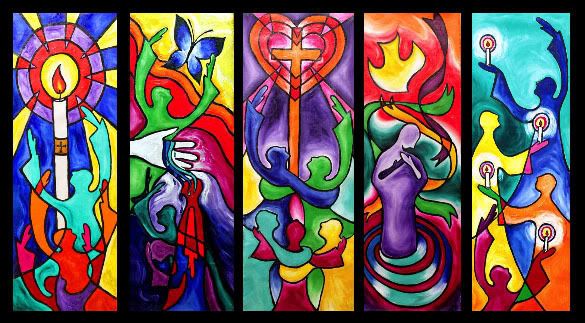
The ceramic butterflies were hand-made and given to worshipers on Easter Sunday as a reminder of the resurrected life to which Jesus calls us.
A Sermon for Easter Sunday
by Pastor Laura Gentry
John 20:1-18
This wonderful Easter morning we have come together celebrate the resurrection of Christ. Throughout our service, we continue to affirm that Christ is Risen, Christ is Risen, indeed. Alleluia! We are all aware that this is a joyful day—a day to dress in our finest clothes, a day to plan a wonderful meal, to come to church with the whole family, to sing our favorite Easter hymns.
And yet, the people at the tomb in this morning’s Gospel didn’t find it so joyful. They weren't having Easter egg hunts and munching on Cadbury cream eggs, or wearing pretty springtime fashions thinking pleasant thoughts about bunnies and about all the half-price pastel M&Ms they were going buy at the after-Easter sales tomorrow. No, they were caught up in the harsh reality that their Lord had died—a reality they did not expect, though Jesus had tried many times to tell them that this was God’s plan. It is a reality they cannot understand or accept—for with Jesus, all their hopes had died. They were deep, deep in darkness.
And it is in darkness that Mary Magdalene makes her way to the tomb that first Easter morning. She has no idea he is risen. She comes before dawn, perhaps because her sorrow has kept her awake all night and she cannot sleep anyway. All she can think about is the fact that her Lord has been crucified. With her hopes dashed and her world in shambles, she has come to his grave, perhaps to grieve in the peace of this garden.
But the serenity of the grace is certainly not what she finds. The sealed tomb has been opened! The huge stone is rolled away! Mary turns and dashes off to find Peter and the other disciple. Out of breath, Mary cries to them, “They have taken the Lord out of the tomb, and we do not know where they have laid him!”
Shocked, the disciples run to the tomb to see if what Mary was hysterically crying about was true. Sure enough, they see the out-of-place stone, the empty linens, the body-less tomb. In this Gospel account, John doesn’t tell us what the two men are thinking or feeling—he just simply says that the other disciple “saw and believed.” He doesn’t even tell us for sure that Peter saw and believed, though we assume so because then the two men turn around and go home. Not very big parts for important disciples. They couldn’t even get a “Best Supporting Actor” for these little cameo roles.
But Mary—Mary deserves a “Best Leading Actress” for her dramatics here. After the two disciples run off, Mary stands weeping outside the tomb. When faced with the empty tomb, Mary doesn’t just “see and believe” so easily like the two disciples. She is still convinced that some opponent of Jesus’ has stolen his body to further undermine her Lord—as if getting him crucified was not enough. She is wrought with grief in this moment—her world has come to an end. I picture her in this scene shaking with sobs, unable to get a hold of herself.
Still trying to comprehend this catastrophe, Mary peeks into the tomb again. This time, it is not empty. This time, she sees two angels hanging out where Jesus was supposed to be, and they casually ask, “Woman, why are you weeping?” We can see that Mary is overtaken by her grief because she seems to lack logic here. If you saw two angels sitting in your loved one’s empty tomb, wouldn’t you start to catch on that something strange is afoot? Not Mary—she goes on to answer the angel’s question as if she’s talking to some regular person, crying, “They have taken away my Lord, and I do not know where they have laid him.”
As if Jesus cannot stand to see Mary grieve another moment longer, he appears. Perhaps she senses him, because she turns right around to face him. Yet, through her tears, she cannot recognize him. He asks her the same question: “Woman, why are you weeping? Whom are you looking for?”
Mary assuming he is the gardener and also the alleged grave robber, addresses him in an accusatory tone: “Sir, if you have carried him away, tell me where you have laid him, and I will take him away.”
Then, Jesus calls her by name: “Mary.” That’s all it takes to turn her tears to cries of joy. She hears her name, recognizes her Lord and responds with the affectionate name she had always called him, “Rabbouni,” the more familiar title used to address teachers.

A parishioner from my congregation in California showed me a painting she had commissioned by the artist Richard Serrin (pictured above), which seeks to visually interpret this passage from John’s Gospel. Mary is outside the tomb, kneeling in darkness, yet her face is mysteriously illuminated. Christ is standing in the background because she has not yet turned to face him. Her hands are clutched in tight fists and there is a cry upon her face. It looks like a cry of anguish but if you look at it for a while, you think it might be a cry of joy. It is as if the artist has caught the precise fraction of a second when one cry transitions into the other. And that very moment, I think, expresses the whole purpose of the Easter story.
Today it is Easter Sunday, 2009. Nearly 2,000 years have passed since that first Easter day. We have come to church to celebrate the Resurrection. And, yes, we are dressed up in our Easter finest but deep inside, I think we can all relate to Mary Magdalene. Like Mary, don’t we carry around a burden of grief in our souls? Perhaps it is the loss of loved ones that grieves us. Perhaps it is the disappointments and crushing blows we’ve suffered in our lives. Perhaps it is the terrible weight of our sins, the unwise choices we’ve made. Perhaps we bear the wounds of pain inflicted by others. Or maybe illness and disease weigh us down. Yes, we confess that Christ is risen. We believe it in our hearts and we know that there is cause for great joy this Easter Day but the grief is there, too. Like Mary, there is a cry of anguished sorrow on our lips.
But just as Mary’s cry was changed into joy, so is ours. As he called her by name, as he under stood her deep need and came to her rescue as the Risen One, so he calls us today. So he rescues us from sin and death. He came to change our human cry of grief into a cry of happy victory. He came to give us a whole new cry!
And what does Mary do, once her cry has been changed—once she has been given a new cry—a faithful cry of joy? She immediately does as Jesus commands her. She runs like the wind to tell the disciples, “I have seen the Lord” and to tell her whole story of how Jesus has transformed her cry.
Do we recognize Jesus? We hear him call us by name? Do we see that Easter is more than just a springtime tradition? Do we see that it is the church’s celebration of the fact Jesus has changed our human condition entirely? It is a celebration that Christ continues to reveal himself to us today in Word and Sacrament: in the Holy Scriptures, in the healing waters of Baptism, in the body and blood of the Lord’s Supper, and in the fellowship of our church community. And in these things, Jesus changes our cry of grief into a victorious cry of joy! And, like Mary, we are called to share with others the good news that Christ is Risen! May we do so with Mary’s exuberant, Oscar-award-winning zeal and proclaim in all we do and say that “Christ is Risen! Christ is Risen, Indeed, Alleluia!”
May the peace of God, which passes all understanding, keep our hearts and minds in Christ Jesus our Lord. Amen.
And yet, the people at the tomb in this morning’s Gospel didn’t find it so joyful. They weren't having Easter egg hunts and munching on Cadbury cream eggs, or wearing pretty springtime fashions thinking pleasant thoughts about bunnies and about all the half-price pastel M&Ms they were going buy at the after-Easter sales tomorrow. No, they were caught up in the harsh reality that their Lord had died—a reality they did not expect, though Jesus had tried many times to tell them that this was God’s plan. It is a reality they cannot understand or accept—for with Jesus, all their hopes had died. They were deep, deep in darkness.
And it is in darkness that Mary Magdalene makes her way to the tomb that first Easter morning. She has no idea he is risen. She comes before dawn, perhaps because her sorrow has kept her awake all night and she cannot sleep anyway. All she can think about is the fact that her Lord has been crucified. With her hopes dashed and her world in shambles, she has come to his grave, perhaps to grieve in the peace of this garden.
But the serenity of the grace is certainly not what she finds. The sealed tomb has been opened! The huge stone is rolled away! Mary turns and dashes off to find Peter and the other disciple. Out of breath, Mary cries to them, “They have taken the Lord out of the tomb, and we do not know where they have laid him!”
Shocked, the disciples run to the tomb to see if what Mary was hysterically crying about was true. Sure enough, they see the out-of-place stone, the empty linens, the body-less tomb. In this Gospel account, John doesn’t tell us what the two men are thinking or feeling—he just simply says that the other disciple “saw and believed.” He doesn’t even tell us for sure that Peter saw and believed, though we assume so because then the two men turn around and go home. Not very big parts for important disciples. They couldn’t even get a “Best Supporting Actor” for these little cameo roles.
But Mary—Mary deserves a “Best Leading Actress” for her dramatics here. After the two disciples run off, Mary stands weeping outside the tomb. When faced with the empty tomb, Mary doesn’t just “see and believe” so easily like the two disciples. She is still convinced that some opponent of Jesus’ has stolen his body to further undermine her Lord—as if getting him crucified was not enough. She is wrought with grief in this moment—her world has come to an end. I picture her in this scene shaking with sobs, unable to get a hold of herself.
Still trying to comprehend this catastrophe, Mary peeks into the tomb again. This time, it is not empty. This time, she sees two angels hanging out where Jesus was supposed to be, and they casually ask, “Woman, why are you weeping?” We can see that Mary is overtaken by her grief because she seems to lack logic here. If you saw two angels sitting in your loved one’s empty tomb, wouldn’t you start to catch on that something strange is afoot? Not Mary—she goes on to answer the angel’s question as if she’s talking to some regular person, crying, “They have taken away my Lord, and I do not know where they have laid him.”
As if Jesus cannot stand to see Mary grieve another moment longer, he appears. Perhaps she senses him, because she turns right around to face him. Yet, through her tears, she cannot recognize him. He asks her the same question: “Woman, why are you weeping? Whom are you looking for?”
Mary assuming he is the gardener and also the alleged grave robber, addresses him in an accusatory tone: “Sir, if you have carried him away, tell me where you have laid him, and I will take him away.”
Then, Jesus calls her by name: “Mary.” That’s all it takes to turn her tears to cries of joy. She hears her name, recognizes her Lord and responds with the affectionate name she had always called him, “Rabbouni,” the more familiar title used to address teachers.

A parishioner from my congregation in California showed me a painting she had commissioned by the artist Richard Serrin (pictured above), which seeks to visually interpret this passage from John’s Gospel. Mary is outside the tomb, kneeling in darkness, yet her face is mysteriously illuminated. Christ is standing in the background because she has not yet turned to face him. Her hands are clutched in tight fists and there is a cry upon her face. It looks like a cry of anguish but if you look at it for a while, you think it might be a cry of joy. It is as if the artist has caught the precise fraction of a second when one cry transitions into the other. And that very moment, I think, expresses the whole purpose of the Easter story.
Today it is Easter Sunday, 2009. Nearly 2,000 years have passed since that first Easter day. We have come to church to celebrate the Resurrection. And, yes, we are dressed up in our Easter finest but deep inside, I think we can all relate to Mary Magdalene. Like Mary, don’t we carry around a burden of grief in our souls? Perhaps it is the loss of loved ones that grieves us. Perhaps it is the disappointments and crushing blows we’ve suffered in our lives. Perhaps it is the terrible weight of our sins, the unwise choices we’ve made. Perhaps we bear the wounds of pain inflicted by others. Or maybe illness and disease weigh us down. Yes, we confess that Christ is risen. We believe it in our hearts and we know that there is cause for great joy this Easter Day but the grief is there, too. Like Mary, there is a cry of anguished sorrow on our lips.
But just as Mary’s cry was changed into joy, so is ours. As he called her by name, as he under stood her deep need and came to her rescue as the Risen One, so he calls us today. So he rescues us from sin and death. He came to change our human cry of grief into a cry of happy victory. He came to give us a whole new cry!
And what does Mary do, once her cry has been changed—once she has been given a new cry—a faithful cry of joy? She immediately does as Jesus commands her. She runs like the wind to tell the disciples, “I have seen the Lord” and to tell her whole story of how Jesus has transformed her cry.
Do we recognize Jesus? We hear him call us by name? Do we see that Easter is more than just a springtime tradition? Do we see that it is the church’s celebration of the fact Jesus has changed our human condition entirely? It is a celebration that Christ continues to reveal himself to us today in Word and Sacrament: in the Holy Scriptures, in the healing waters of Baptism, in the body and blood of the Lord’s Supper, and in the fellowship of our church community. And in these things, Jesus changes our cry of grief into a victorious cry of joy! And, like Mary, we are called to share with others the good news that Christ is Risen! May we do so with Mary’s exuberant, Oscar-award-winning zeal and proclaim in all we do and say that “Christ is Risen! Christ is Risen, Indeed, Alleluia!”
May the peace of God, which passes all understanding, keep our hearts and minds in Christ Jesus our Lord. Amen.








No comments:
Post a Comment